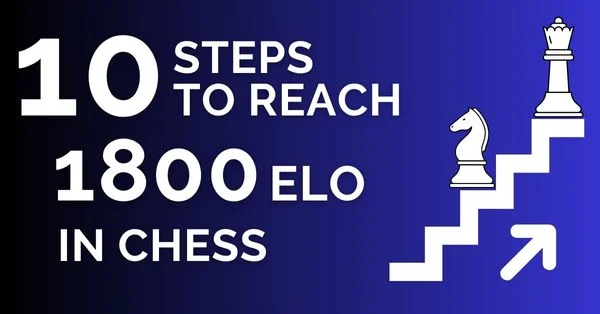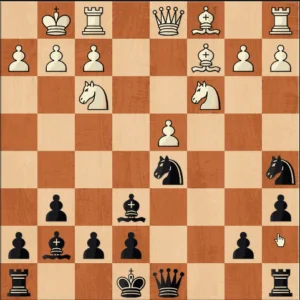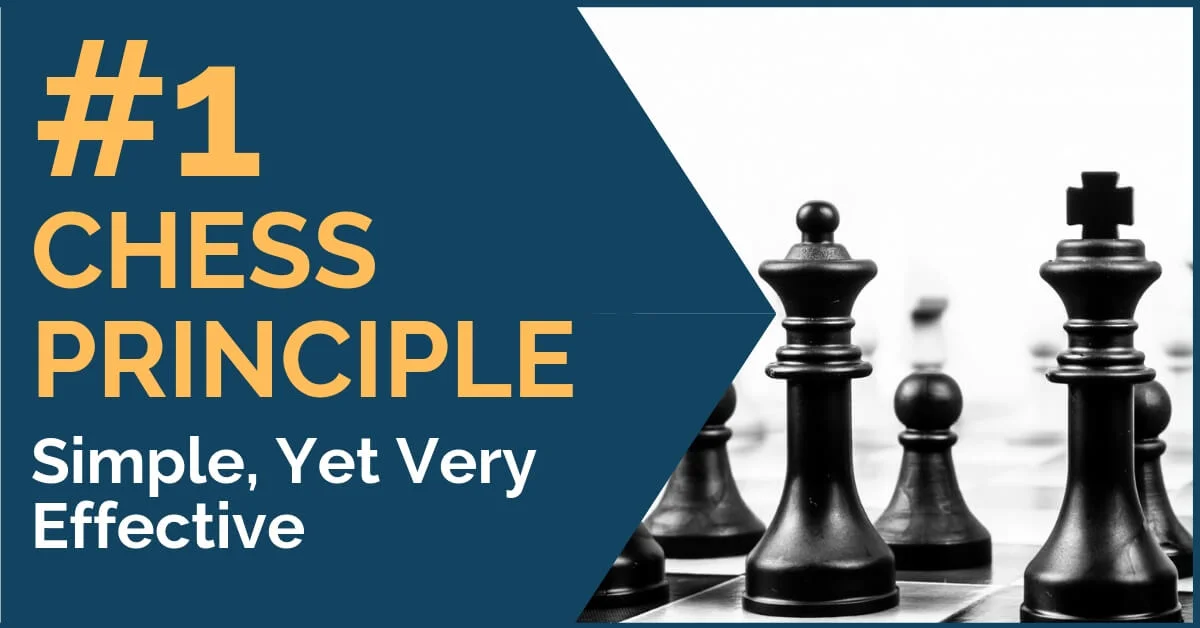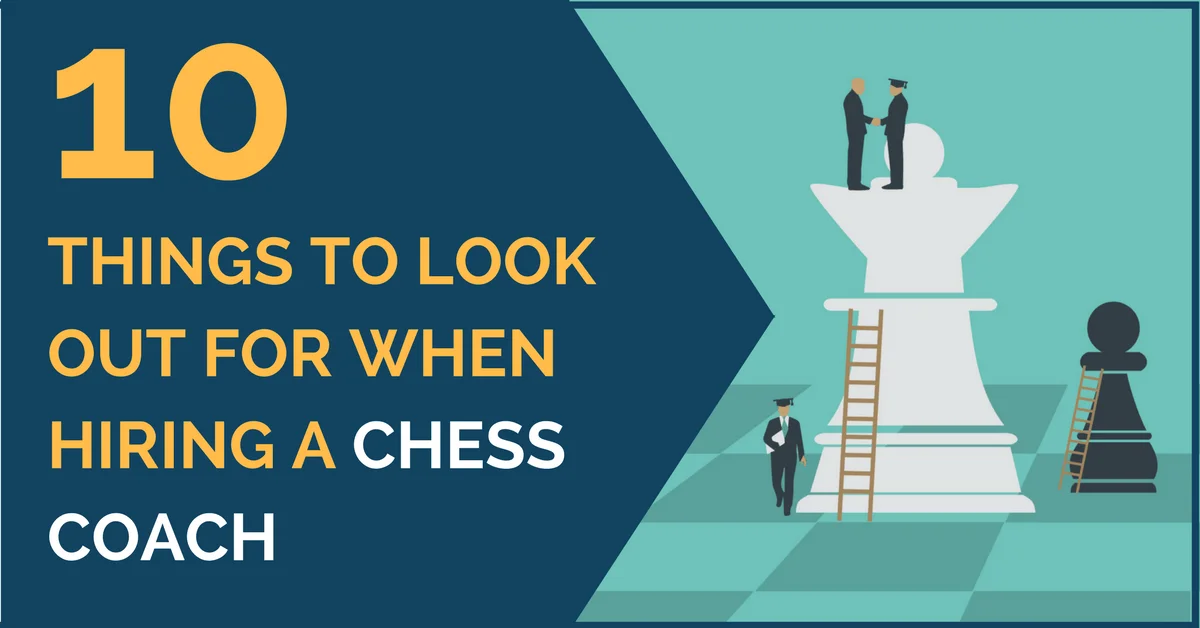10 Steps to Reach 1800 Elo in Chess

Ratings serve as significant indicators of personal and professional success for chess players. Ranging from 1000 to 2800+, the ultimate goal for many enthusiasts is to achieve an 1800 Elo rating.
Surpassing this milestone places a player statistically better than 95% of all others. The pursuit of 1800 Elo is indeed an attainable ambition for any dedicated chess player armed with the right training and strategic approach.
In this article, we will explore the logical and systematic steps that can lead you to accomplish the coveted 1800 rating in chess.
1. Opening Study
To reach 1800 Elo and go beyond you will need a have an opening repertoire. The openings played are not always necessary to fit the player’s style. What’s important is that the openings should be known very well.
Choosing an Opening
Given the current abundance of opening material, it’s easy to fall into Choice Overload i.e. the phenomenon where we feel overwhelmed by the greater number of options and fail to make the most optimal choice.
The solution is easy. Below the Master level, any opening can be employed with success. But remember to know your openings very well. Focus on the depth of your opening then widen the repertoire. A narrower repertoire increases the probability of reaching a known position.
Is Memorization important to get to 1800?
The ability to apply general principles and calculation ability in handling the opening greatly overrides memorized opening lines.
If your memory is excellent, it gives an added advantage to memorizing opening lines. In all other cases, it would be wise to spend time learning the ideas behind chess openings and learning various tabiyas.
So in conclusion, Having a good memory helps but it is not all there is to opening play.
Want to learn how to reach the 1800 Elo quicker? Learn to avoid common chess mistakes for under 1800 elo.
2. Mastering Middlegame Elements
The middle game is the heart of chess, where plans and tactics come into play. To excel in this critical phase, focus on mastering key middlegame elements such as pawn structures, piece coordination, and positional understanding.
Studying middlegames should not be a separate endeavor but should be done in tandem with opening study.
Let’s take an example, The opening being studied is the Caro Kann Panov variation and the following position arises.

Now you should analyze how to play the following middle game. Firstly identify what are the major characteristics of the middlegame position. In this position white has an isolated pawn and the play revolves around it. Check if you have all the knowledge required to play a position with the isolated pawn. Then you should search for all the master games from this position and understand how master-level players continued the position.
Some of the questions that to be asked when analyzing are:
- What are the typical maneuvers?
- What are the typical exchanges?
- What endgames are favorable for both sides?
Studying classic games by renowned grandmasters can provide valuable insights into middlegame strategies and decision-making.
3. Endgame Study
Players with an Elo rating of 1800 and above have a good understanding of the basics of the endgame. Learn essential endgame techniques, such as king and pawn endgames, rook endgames, and minor piece endgames. It’s essential that understanding fundamental theoretical positions and grasping endgame principles be given priority.
An efficient way to learn endgames is to look at the endgames that arise in your games and analyze them thoroughly. Find all the other endgame possibilities that could’ve occurred over the board.
Learning endgames in such a manner helps you build an anchor to that particular endgame and hence remember the nuances better.
Knowledge of Rook endgames is a must and basic positions like Lucena, Philidor, Saavedra, etc should be thoroughly studied and played multiple times against a friend or a computer.
4. Blindfold Chess
Blindfold chess may appear to be a difficult task, but it is a fantastic way to strengthen your visualization and math skills. Begin with simpler positions and progressively progress to more difficult ones.
Blindfold chess improves memory and requires you to carefully analyze positions, giving you a more resourceful and adaptable player. You’ll notice a substantial boost in your general chess skills as you become more comfortable playing blindfold chess.
5. Combinations
After improving your visualization skills. Players should progressively attempt combinations. Combinations are comprised of multiple tactical themes that come together to gain a decisive advantage.
1800 Players are good at spotting tactics for themselves and their opponents. Therefore, aspiring 1800 players must level up their tactical skills and practice combinations.
6. Improving Calculation Ability
An important factor separating 1800 or Class A players from others is their calculation ability, especially in tactical positions. A common problem encountered is the calculation ceiling i.e. after a certain set of moves the position in your mind’s eye gets fuzzy and it becomes unpleasant to calculate or impossible to visualize certain changes.
Different players have different calculation ceilings. To increase your level, you have to improve your personal calculation ceiling.
Resistance also occurs when we are satisfied with the variations we have computed thus far and stop calculating further, even if we should to ensure that we have not missed anything crucial.
A good tip to improve this is to force yourself to see one move further than wherever you’d stop your calculations.
7. Game Analysis
Through game analysis, you can identify both your strengths and limitations, allowing you to discover repeating patterns in your gameplay and uncover positive and negative habits that need attention.
Game analysis can be done individually, involving a review of your moves and ideas during the game, or in a group setting, where you share your games and thoughts with more experienced players or instructors. In group analysis, you can receive valuable feedback, tips, and insights that can aid in your chess improvement journey.
8. Good Moves Are Enough
Modern time controls force chess players to play practically. Make objective decisions on the board. When playing higher-rated players if you have several reasonable continuations, play a move that is good enough to keep the game going.
It is not necessary to find the most precise move by spending a huge chunk of time. Playing practical chess against higher-rated opponents can pay huge dividends. Of course, you might miss out on those one or two brilliant prizes but on the other hand, you’ll defiantly increase your rating.
9. Psychological Elements
Fear of higher-rated opponents is a prevalent psychological challenge that many chess players face on their journey to improvement.
It is entirely natural to feel intimidated or anxious when facing opponents with higher Elo ratings, as it often translates to greater experience and expertise. However, allowing this fear to consume you can hinder your progress and undermine your performance on the board.
As this one factor has the potential to negate all your improvements in the critical positions Therefore it is very important to keep your mental state in top condition.
Looking to break the next Elo goal? Learn how to reach 2000 Elo.
10. Learn from Great Players
One of the most effective and time-tested methods to enhance your chess skills is by studying master games. Observing the strategies and moves of renowned grandmasters can provide valuable insights, helping you broaden your understanding of the game and refine your playing style.
Studying the games of all the World Champions is a very good starting point. Their games are of the top quality and you’re bound to learn a lot from their games. Especially the Former World Champion Magnus Carlsen, believed by many to be the Greatest of All Time. His games demonstrate a clear logic that can be highly instructive to all aspiring players.
https://thechessworld.com/store/product/play-chess-like-magnus-carlsen-with-fm-viktor-neustroev/
FAQ
How long does it take to get to 1800 Elo?
The timescale depends on several factors like time devoted to chess, tournament selection, etc. On average an adult player takes 3-4 years to reach 1800 Elo.
Is 1800 Elo a good chess rating?
Having a rating of 1800 makes you better than 95% of all chess players. So it’s a good chess rating to have.
How hard is it to get to the 1800 rating in chess?
Getting to 1800 requires long-term hard work, perseverance, and patience from the player.
Is Elo rating 3000 possible?
No human to date has reached the rating of 3000. Maybe in the future, it could be possible.
What percentile is 1800 Elo?
1800 Elo comes within the 91st percentile of all chess players.










Comments: